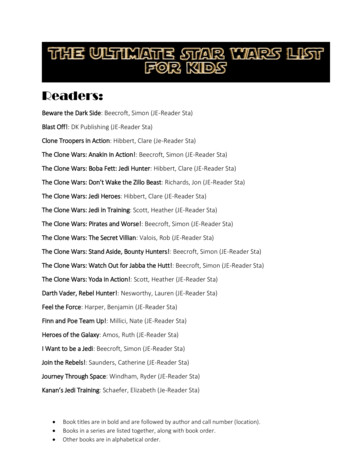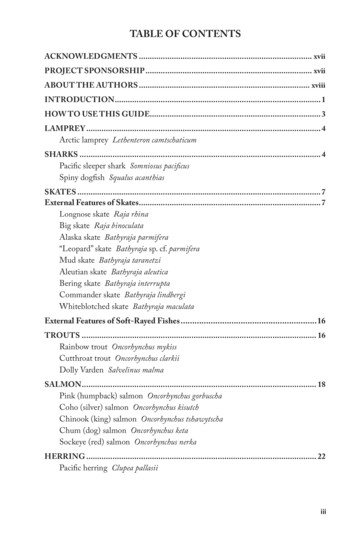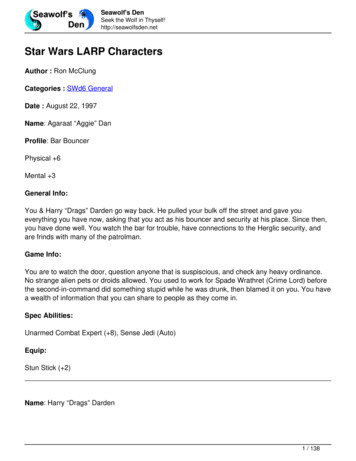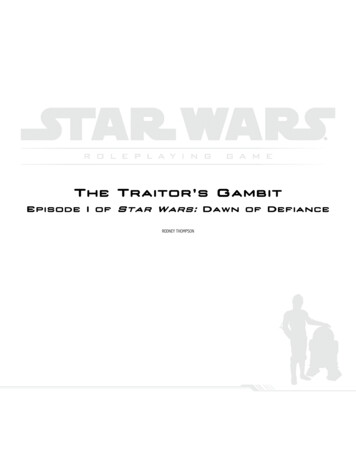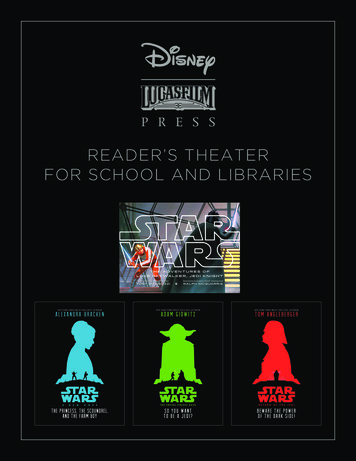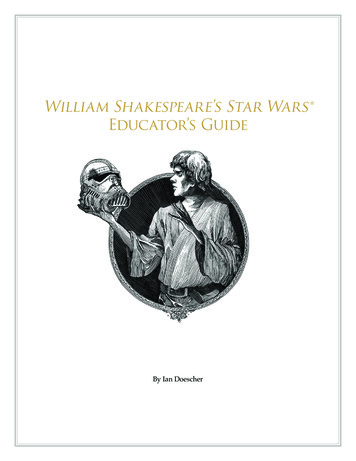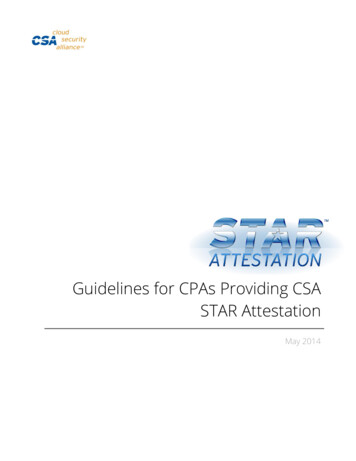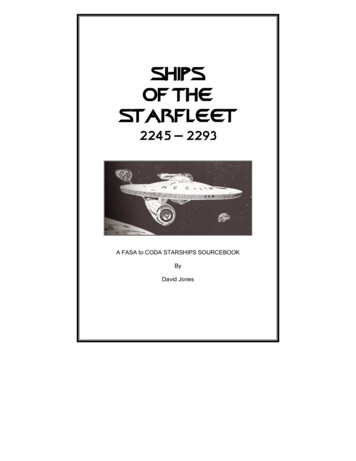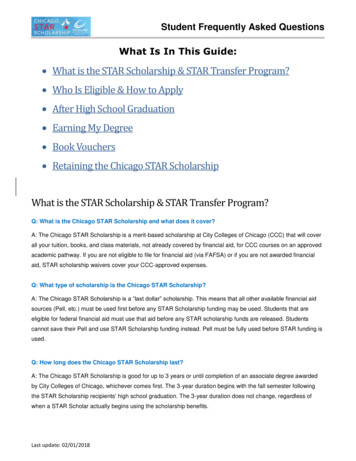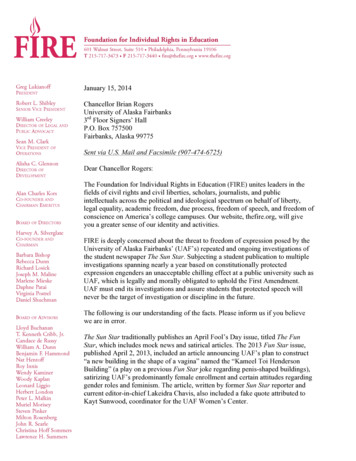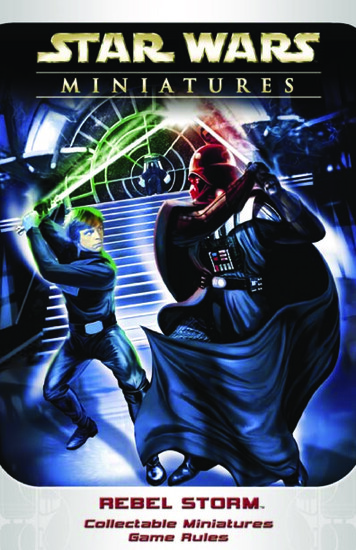
Transcription
Star Wars Miniatures Starter Set ComponentsRules summary sheet2 exclusive prepainted plastic miniatures: Luke Skywalker, Rebeland Darth Vader, Dark Jedi8 randomized prepainted plastic miniatures10 stat cards, one for each figureBattle grid (play mat)8 terrain tilesRules bookletDamage and Force counters20-sided die (1d20)Rebel Storm set checklistStar Wars Skirmish Rules CreditsGame Design and Development: Bill Slavicsek, Jeff Grubb, Jonathan Tweet, and Rob WatkinsSpecial Assistance: Christopher PerkinsEditing: Jennifer Clarke WilkesArt Direction—Sculpture: Stacy LongstreetArt Direction—Print: Mari KolkowskySketch Artists: Des Hanley, Greg Staples, and Stephen TappinPainters: Eve Forward-Rollins and Dylan S.Package Art: Clark MitchellGraphic Design: Mari Kolkowsky, Leon Cortez, Lisa Hanson, and Jennifer LathropCartography: Christopher West, and Kyle HunterCategory Managers: Chris Toepker and John StickfordDesign Manager: Jonathan TweetDirector of RPG/Miniatures R&D: Bill SlavicsekProject Manager: Martin DurhamProduction: Chas DeLong, Linae Foster, Sampson He, and Yenvik ZhongPlaytesters: Jeff Grubb and Mons JohnsonBased on the Star Wars Roleplaying Game by Bill Slavicsek, Andy Collins, and JD Wiker, utilizing mechanics developed for the new DUNGEONS& DRAGONS game by Jonathan Tweet, Monte Cook, Skip Williams, Richard Baker, and Peter Adkison, and the D&D Miniatures Skirmish Rulesby Rob Heinsoo, Skaff Elias, and Jonathan Tweet.This Wizards of the Coast game product contains no Open Game Content. No portion of this work may be reproduced inany form without written permission. To learn more about the Open Gaming License and the d20 System License,please visit www.wizards.com/d20.U.S., CANADAASIA, PACIFIC, & LATIN AMERICAWizards of the Coast, Inc.P.O. Box 707Renton, WA 98057-0707Questions? 1-800-324-6496300-96670-001-ENEUROPEAN HEADQUARTERSWizards of the Coast, Belgium’T Hofveld 6d1702 Groot-BijgaardenBelgium 322-467-3360 2004 Lucasfilm Ltd. & TM. All rights reserved. Used under authorization. DUNGEONS & DRAGONS, D&D, d20 System, D&D Miniatures,Star Wars Miniatures, Wizards of the Coast, and their respective logos are trademarks of Wizards of the Coast, Inc., a subsidiary of Hasbro, Inc.,in the U.S.A. and other countries. 2004 Wizards of the Coast, Inc.www.starwars.comDistributed to the hobby, toy, and comic trade in the United States and Canada by regional distributors. Distributed in the United States to thebook trade by Holtzbrinck Publishing. Distributed in Canada to the book trade by Fenn Ltd. Distributed worldwide by Wizards of the Coast, Inc. andregional distributors. This material is protected under the copyright laws of the United States of America. Any reproduction or unauthorized useof the material or artwork contained herein is prohibited without the express written permission of Wizards of the Coast, Inc. This product is awork of fiction. Any similarity to actual people, organizations, places, or events is purely coincidental. Made in the USA.First Printing: August 2004987654321www.wizards.com
IntroductionIt is a time of Galactic Civil War.During this dark period, the Rebel Alliance wages a desperate war to end thetyrannical reign of the Empire. Outnumbered and outgunned, the Rebels fight onas the overwhelming Imperial forces seek to crush them once and for all . . .The classic trilogy of Star Wars films—A New Hope, The Empire Strikes Back, and Returnof the Jedi—is the backdrop for this fast-paced, action-packed miniatures game. Using theamazing heroes, villains, aliens, and characters from the Rebellion era, this competitivecombat game lets you determine the outcome of battles taking place during the GalacticCivil War. Imagine yourself as the commander of a squad of Rebel troopers or Imperialsoldiers. You choose your faction. You select your troops. You issue the orders. And it’sup to you to prove yourself against the competition in head-to-head action set in theStar Wars universe.Do you play the Star Wars Roleplaying Game? The miniatures in this Starter Set aredesigned specifically to use in adventures. The Gamemaster will find a fantastic collectionof allies and opponents in this Starter Set and add-on Booster Packs that contain morefigures. Players will find the perfect representations of existing characters and new figuresthat will serve as inspiration for characters they’ll create in the future.Will you rely on the tenacity of Rebel heroes, the lethal efficiency of armor-clad Imperials,or the versatility and adaptability of those who operate on the Fringe? Each faction hassomething different to offer to your ever-growing squads. In the Star Wars Miniaturesskirmish game, an unlimited combination of movie characters and tactics exist to help askilled strategist overcome any challenge and win the day—if the Force is with you!Three Ways to PlayUse Star Wars Miniatures to: Play using the competitive Star Wars Miniatures skirmish rules detailed in this book. Collect the Star Wars fantasy, from Imperials to Rebels, droids to bounty hunters,and more. Star Wars Miniatures Booster Packs, sold separately, provide moreminiatures for either head-to-head or roleplaying game play. Represent characters and creatures in the Star Wars Roleplaying Game. These officialminiatures are designed for use with all Star Wars Roleplaying Game products.Skirmish RulesAcross the expanse of the galaxy, elite Imperial units clash with Rebel strike teams in furiousbattles to decide the Galactic Civil War. This booklet provides the rules for fast, tacticalminiatures battles (skirmishes) in the Star Wars universe.In a skirmish, a Rebel squad and an Imperial squad battle each other.The winner is the player whose squad defeats all the enemy characters.For other sorts of scenarios, including multiplayer and teamskirmishes, see Scenarios on page 23.1
CharactersEach miniature figure represents a character from the Star Wars universe. (These rules referto all miniatures as “characters.”) Each character has a corresponding stat card that lists gamestatistics for the skirmish rules.How to Read a Stat CardLook at the stat card displayed below.Faction SymbolNameEMPEROR PALPATINEHit Points130Cost40Special AbilitiesUniqueDefense20Attack 0Damage0StatisticsForce PowersForce PowersForce 4Force Lightning (Force 2, replaces attacks:range 6; 30 damage to 1 target and up to2 characters adjacent to that target)Force Renewal 1 (This character gets Force1 each time he activates)Force Wave (Force 2, replaces attacks:20 damage to all adjacent characters)Collector NumberSet IconFactionCommander EffectCostNameCharacters in your squad can spend EmperorPalpatine’s Force points. (A character stillcan’t spend Force points more than once perturn and can’t combine its own Force pointswith Emperor Palpatine’s.)Copyright Notice25/60 Set Icon /Collector Number/Rarity Symbol 2004 Lucasfilm Ltd. & TM. All rightsreserved. Game Design: WizardsRarityCopyright NoticeNameMatch the name on each stat card to the name on the base of the miniature.Faction SymbolYour squad belongs to a specific faction, which corresponds to the sides participatingin the Galactic Civil War that rages during the Rebellion era. The factions are: the RebelAlliance, the Empire, and the Fringe.2
Each character’s stat card has a symbol that identifies which faction it can fight for. Characterswith the Fringe symbol can fight for any faction and so can be added to any squad.CostThe cost is the number of points you pay to add a character to your squad. A squad canhave up to 100 points of characters in it.StatisticsThis section provides information pertinent to game play.Hit Points represent how much damage a character can withstand before falling in battle.When a character’s Hit Points are reduced to 0, the character is defeated and removedfrom the battle grid.Defense represents how hard the character is to hit in combat. An attacker must roll thisnumber or higher to hit the character and deal damage.Attack is a measure of how effective the character is in combat, whether with a blaster,vibroknife, or claws. When the character makes an attack, roll the 20-sided die (1d20) andadd this number. If the result equals or exceeds the enemy’s Defense, the attack hits.Damage is how much damage the character deals when an attack hits.Special AbilitiesThese include any special attacks, qualities, or limits a character has. Special abilities mayoverride the general rules.Force PowersSome characters have a Force rating, which is a number of points they can spend touse Force powers. Using a Force power costs Force points, as described in the power’sdescription. Characters with Force points can also use them to reroll bad rolls or tomove faster. Some characters with Force ratings have no Force powers; they can onlyuse their Force points to reroll or move faster.Commander EffectSome characters can help the rest of their team, directing them, encouraging them, orcoordinating their attacks. These effects are listed here.Set Icon/Collector Number/Rarity SymbolThe icon tells you what set a miniature belongs to, such as the Rebel Storm set (whoseicon is the Stormtrooper helmet ). The collector number lists the miniature’s order inthe set, as well as the total number of miniatures the set contains.The rarity symbol indicates how easy the miniature is to find. There are four levels ofcollectability: common , uncommon , rare , and very rare .3
Building a SquadIn a skirmish, one player builds a Rebel squad, the other an Imperial squad.FactionsThe Galactic Civil War, marked by such famous engagements as the Battle of Yavin, theBattle of Hoth, and the Battle of Endor, is primarily fought between two factions—thetyrannical Empire and the freedom-fighting Rebel Alliance. A third faction, made up ofindependent crime lords, mercenaries, smugglers, and bounty hunters, is known as theFringe. Members of the Fringe can can join forces with either the Empire or the Rebels.When building a squad, first choose the faction the squad belongs to. Each character’s statcard gives its game statistics, including a faction symbol that shows which faction it canfight for.THE REBEL ALLIANCEThe Alliance to Restore the Republic, commonly known as theRebellion or the Rebel Alliance, is opposed to the tyrannicalrule of the Empire and its New Order. Fighting from secretbases and constantly on the move, the Rebels revere the idealsof the Old Republic and look to the Force for inspiration andguidance in their struggle to overthrow the Empire.THE GALACTIC EMPIREA regime of tyranny and evil, the Empire was carved fromthe dying corpse of the Old Republic. The Emperor uses hisvast powers and Imperial war machine to subjugate planets,bolster his personal glory, and spread his doctrine of rule byfear throughout the galaxy. The Empire considers the Rebellionto be insignificant; an annoyance at best that will be crushed bythe iron fist of the Imperial forces.THE FRINGEFor the most part, members of the Fringe exist in the shadowyplaces beyond the scope of law and order. All manner ofscoundrels and free agents inhabit the Fringe, each looking tomake a quick credit or following their own code of conduct.They go where the money is, or where their ideals take them,usually rejecting established authority. Characters belonging tothe Fringe faction can fight for either side—Rebel Alliance orGalactic Empire.4
Squad ConstructionAfter choosing a faction, start selecting characters to fight in your squad. You can spendup to 100 points to build your squad.Cost: Each character has a point cost shown on its base and the top right corner of itsstat card.Factions: Your squad can contain characters that possess your faction’s symbol or theFringe symbol. One player (the Rebel player) constructs a squad of Rebel Alliance andFringe characters, while the other (the Imperial player) constructs a squad of GalacticEmpire and Fringe characters.SAMPLE REBEL SQUADCharacterCostIG-8837Luke Skywalker, Rebel17Rebel Officer135 Rebel Trooper25R2-D28Total Characters 9 Total Cost 100Squad-Building EtiquetteConstruct your squad in secret, using the stat cards. Don’t identify which characters you’reusing yet; just keep your hand of stat cards ready.You reveal your squad when setting up the skirmish.THE RIGHT SQUAD FOR THE RIGHT BATTLESquads have different strengths and weaknesses, depending on the mix of characters andthe factions they belong to. Try creating several different squads and get a feel for how theyplay. Each rewards different strategies and tactics. One might consist of a large number oflow-power characters, another could feature a few very powerful characters, while a thirdcombines the two combat styles in some unique manner. The more combinations you try,the more tricks and tactics you learn—and the more you’ll win!SetupThis Entry Pack contains a battle grid, a two-sided sheet overlaid with a grid of 1-inchsquares. If you want to get playing fast, use the side of the battle grid with the printedmap (this represents a portion of a deck on the Death Star).If you prefer, you can instead use the blank side of the battle grid and set up your ownbattlefield. See Scenarios on page 23 for more information.SeatingSet the battle grid on the table. Players sit at opposite ends: the Rebel player at the endwith the Hangar Bay section and the Imperial player at the end with the turbolifts.The edges of the battle grid are impassable walls. There is no way off the battle grid.5
Assemble Your SquadBoth players reveal their squads. The Rebel squad starts in the Hangar Bay section, witheach character on the spaceship. (If there isn’t room for all characters, the remaining onesstart as close as possible to the ship.) The Imperial squad starts in either or both of theturbolifts in the opposite end of the battle grid.The Rebel squad sets up first, then the Imperial squad. After you set up your squads, rollfor initiative to start the skirmish.Skirmish BasicsOnce you have chosen your squad and set up the battle grid, you and your opponenttake turns activating the characters in your squads.How to WinYou win by defeating all the enemy characters. (Other scenarios and ways to win starton page 23.)Tie-Breaker: If no character has damaged an enemy character, made an attack roll, orforced an enemy character to make a save for 10 rounds in a row, total up the pointsfor characters who have been defeated. The player who has defeated the most points’worth of characters is the winner. If players are tied, the winner is the player who has acharacter closest to the center of the battle grid. If players are still tied, the player withthe highest-cost character nearest the center is the winner.Initiative RollA skirmish begins with an initiative roll to determine who goes first. Each player rolls1d20. The player with the higher initiative roll chooses who goes first. (Reroll ties.)Sometimes you’ll want to go first; other times you’ll want to see what your opponentis up to before committing your forces.Rounds, Phases, and TurnsA skirmish is played in rounds.In each round, players activate characters in their squads to take actions, each activatingtwo characters at time.First Player: Activates two characters, one at a time. Activating two characters this wayis called a phase.Second Player: Activates two characters, one at a time.First Player: Activates two more characters. These are characters that have not beenactivated yet this round.Second Player: Activates two more characters. These are characters that have not beenactivated yet this round.Repeat until all the characters have activated. Sometimes a player has more charactersthan his or her opponent and activates many characters at the end of the round.Each character can be activated only once in a round. When a character activates, that isthe character’s turn. To indicate that a character has been activated in a round, turn itsstat card or change the direction the miniature is facing.6
A round ends when all players have activated all their characters once. Then a new roundbegins with a new initiative roll.Activating CharactersAn activated character can do one of the following things. Move up to 6 squares and then attack; or Attack and then move up to 6 squares; or Move up to 12 squares (and not attack).“Replaces Attacks”: Sometimes a special ability or Force power says that it “replacesattacks.” In this case, a character can use that special ability or Force power instead ofmaking its usual attack. A character can move up to 6 squares before or after using sucha special ability or Force power, just as if it were an attack.MovementDuring its turn, a character can move up to 6 squares and attack, attack and then moveup to 6 squares, or move up to 12 squares (but not attack).Diagonals: When moving or counting along a diagonal path, each diagonal counts as 2 squares.Corners: A character can’t move diagonally past the corner or end of a wall that extendsto a grid corner (see Terrain on page 20).Other Characters: A character can move through a space occupied by an ally, but it can’tend its move in an occupied square. A character cannot move through a space occupiedby an enemy. Even moving while adjacent to an enemy is dangerous. See Attacks ofOpportunity, below.MovementLuke Skywalker11, 2243561, 23, 4, 5, 63, 456Moving diagonally costs double. A character can’t movediagonally past the corner or end of a wall. Moving throughlow objects also costs double.If a character moves diagonally through low objects, thecost of movement doubles twice.7
Terrain: Features on the battle grid and terrain tiles can affect movement. See Terrain onpage 20.Low Objects: It costs double to move into a square with low objects. (Moving diagonallyinto a square containing low objects costs 4 times as much.)Walls and Pits: Walls and pits block movement. Some big objects count as walls.Doors: Doors act like walls while closed and have no effect while open.Large Characters and MovementLarge characters occupy a space 2 squares wide and 2 squares long. They pay the extracosts for moving into low objects if any part of their space moves into a square containinglow objects. They cannot move if any part of their space would move into a squarecontaining an enemy.Squeezing: Large characters can squeeze through small openings (such as single-squaredoors) and down narrow hallways, provided that they end their movement in an areathat they can normally occupy. Large characters cannot squeeze past enemies.Attacks and DamageSome characters in the Star Wars universe attack with blasters, others use vibro weapons,and others wield lightsabers. When a character attacks an enemy, you choose your target,make an attack roll, and, if the attack roll hits, deal damage.Squeezing61Wampa82345A Large character takes up 4 squares on the battle grid.A Large character can move through a space that is narrowerthan its own (such as between walls or obstacles) but can’tstop where it doesn’t fit. A Large creature cannot squeezethrough a space that is narrow because of enemy characters.
Line of SightRoyal GuardStormtrooperLuke SkywalkerTwo characters have line of sight to (can see) each other if there’s at leastone clear line between their spaces. A line that nicks a corner or runs alonga wall does not provide line of sight. In this example, Luke can see theStormtrooper but not the Royal Guard.A character needs line of sight to an enemy to attack that enemy. Luke canattack the Stormtrooper but not the Royal Guard.Choosing Targets 1Luke SkywalkerRoyal GuardOKOKTuskenRaiderStormtrooperA character can attack an enemy with cover only if thatenemy is the nearest one to the attacker (or tied fornearest). In this example, Luke can attack either theTusken Raider or the Royal Guard. He can’t shoot theStormtrooper because it has cover against him and it’snot the nearest enemy.9
Choosing Targets 2Han SoloLuke SkywalkerRoyal GuardStormtrooperIf one or more enemies are adjacent to an attacking character, the attackermust choose one of those enemies as the target. In this example, Han can’tattack the Stormtrooper because the Royal Guard is adjacent to him.A character can attack an enemy with cover only if that enemy is the nearestone to the attacker (or tied for nearest). In this example, the Stormtroopercan attack either Luke or Han. The Royal Guard gives cover to Han ( 4 bonusto Defense), but since Han and Luke are both 5 squares away from theStormtrooper, the Stormtrooper can choose to shoot Han anyway.Choosing Your TargetBefore making an attack, choose which enemy the character is targeting.Line of Sight: The attacker must be able to see the enemy. See Line of Sight, below.Cover: A character can’t target an enemy that has cover unless that enemy is thenearest. See Cover, below.Adjacent Enemies: If enemies are adjacent to the character, it can target only one ofthose enemies.Line of SightGenerally, a character can target any enemy (called the defender) it can see. Seeing adefender is determined by finding line of sight. Draw an imaginary line from any point inthe attacker’s space to any point in the defender’s space. If the player who controls theattacking character can draw that line without touching a wall, that character has line ofsight to that defender. A line that nicks a corner or runs along a wall does not provide lineof sight. Only walls, closed doors, and big objects that count as walls block line of sight.Characters, low objects, and pits do not block line of sight.CoverCharacters and certain kinds of terrain, such as low objects and walls, can provide coveragainst attacks. A character can attack an enemy with cover only if it’s the nearest enemy.Even if the attacker can attack the enemy with cover, the enemy gets a 4 bonus to itsDefense for having cover.10
CoverLuke SkywalkerRoyal GuardTo find out whether a defender has cover against an attack, theattacker chooses a corner in its space. If any line from thatcorner to the target’s space is blocked by a wall or otherobstacle, goes through a square with a character in it, or goesthrough a square with low objects in it, then the target hascover and gets a 4 bonus to its Defense. A character canattack an enemy with cover only if it’s the nearest enemy.Stormtrooper 4 DefenseIn this example, there is a clear line from Luke’s chosen cornerto the Stormtrooper’s space. Some lines between this corner andthe Stormtrooper’s space, however, go through a wall, so theStormtrooper gets cover ( 4 bonus to Defense) against Luke’sattack. Luke can shoot the Stormtrooper even though it hascover because it’s the nearest enemy.To determine whether an enemy has cover, the player who controls the attacking characterchooses a corner of a square in the attacking character’s space. If any line traced from thispoint to any point in the enemy’s space passes through a wall or a square that providescover, the enemy has cover.The enemy does not have cover if the line runs along or merely touches the edge of a wallor other square that would otherwise provide cover.No matter how many terrain features or characters provide a character with cover, it getsthe 4 bonus to Defense just once. A character never has “double cover.”An adjacent enemy never has cover.Low Objects and Cover: Low objects provide cover to enemies in those squares. However,an attacking character ignores low objects in its own space and adjacent squares. Lowobjects in the attacker’s space and in adjacent squares don’t provide cover to enemies. Theattack can “shoot over them.”Characters and Cover: Characters provide cover, whether they’re allies or enemies.Making AttacksMaking an attack means first making an attack roll and then, if the attack hits,dealing damage.Attack RollsWhen your character attacks, you make an attack roll. Roll 1d20, add the character’sAttack number, and add any other modifiers that apply.11
Cover and Line of SightLuke SkywalkerLuke SkywalkerNo lineof sightNo lineof sightStormtrooperStormtrooperLuke SkywalkerLuke SkywalkerNo coverNo coverStormtrooperStormtrooperA line that runs along a wall or that nicks a corner of a wall does not provide line of sight. But if some otherline does provide line of sight, a line that runs along a wall or that nicks a corner also does not grant cover.When determining line of sight or cover, don’t count lines that run along walls or that nick corners.12
Cover from Low Objects 1Luke SkywalkerStormtrooper 4 DefenseRoyal Guard 4 DefenseHan SoloTusken Raider 4 DefenseIf a line from the attacker’s chosen corner to the defender’s space passes through a square containinglow objects or another character, the defender has cover ( 4 bonus to Defense).In this example, Han can attack one of the three enemies. The low objects provide cover to the RoyalGuard and Tusken Raider. Luke provides cover to the Stormtrooper. Since these three enemies are equallyclose to Han, he can shoot any one of them even though they have cover.Cover from Low Objects 2Tusken RaiderRoyal GuardStormtrooperLuke SkywalkerWhen checking to see whether the target of an attack has cover, the attacker can ignore low objects inits own space and in adjacent squares. Low objects in these squares don’t provide cover to enemies.In this example, Luke can attack either the Stormtrooper or the Royal Guard. Neither enemy has coveragainst his attack. The Tusken Raider, however, has cover from the low objects. Since the Tusken Raiderhas cover and is not the nearest enemy, Luke can’t shoot that character. If the Stormtrooper shot Luke,Luke would have cover ( 4 bonus to Defense) from the low objects in his square.13
If the result of an attack roll equals or exceeds the enemy’s Defense, the attack hits.The attacking character deals damage (its Damage number), which reduces the enemy’sHit Points.For example, Luke Skywalker, Rebel shoots at Darth Vader, Dark Jedi. The Rebel player rolls1d20 and adds 7 for Luke’s Attack. The die comes up 15, for a total of 22. Vader’s Defense is22, so that’s a hit (just barely). Luke’s Damage is 20, so Vader loses 20 Hit Points. He dropsfrom 140 to 120.Natural 20 is a Critical Hit: If you roll a natural 20 when making an attack roll (a roll of20 on the die, regardless of modifiers), the attack automatically hits, no matter how highthe defender’s Defense. In addition, it is a critical hit and deals double damage. Droidcharacters are immune to critical hits and do not take double damage, but a natural 20still hits automatically.Natural 1 is an Automatic Miss: If you roll a natural 1 when making an attack roll (a rollof 1 on the die, regardless of modifiers), the attack automatically misses, no matter howhigh the bonus on the attack roll is.Attack Roll: 1d20 Attack number.A total equal to or greater than Defense is a hit.A hit deals damage, which reduces Hit Points.Shooting past CharactersLuke SkywalkerRebel TrooperStormtrooperLuke SkywalkerRebel TrooperStormtrooper 4 DefenseCharacters do not block line of sight. They do grant cover toother characters behind them. In this example, Luke can shootthrough the Rebel Trooper’s space to attack the Stormtrooper,but the Stormtrooper gets cover ( 4 bonus to Defense).14
ATTACKING ALLIED CHARACTERSA character cannot attack an allied character.This restriction doesn’t prohibit the use of special abilities and Force powers that alsoharm allies—only attacks.Damage and Hit PointsWhen an attack hits, it deals damage that reduces the enemy’s Hit Points. You can use thecounters in this Starter Set to keep track of damage.Reduced to 0 Hit Points: When a character’s Hit Points drop to 0 or lower, it is defeatedand removed from the battle grid.Combined FireMultiple characters can combine their attacks in combined fire. When a charactermakes an attack on its own turn, allied characters that have not yet activated this roundcan combine fire to aid in the attack. These allied characters must have line of sight tothe target. Characters with the Melee Attack special ability, or characters that deal nodamage, cannot use or benefit from combined fire.These allied characters activate immediately, and give the attacker a 4 bonus to Attackfor each character activated in this fashion. The characters don’t do anything with theiractivation other than grant the combined fire bonus, and they can’t activate again thatround. In a sense, the characters give up their turns for the round to aid in the attack.You have to decide which allies combine fire before making the attack roll. You can’t makethe attack roll and then decide how many allies help out with combined fire.The bonus from combined fire is only good for a single attack. If a character has a specialability that lets it make more than one attack on its turn, the bonuses are good only forthe attack to which they are applied.You can’t combine fire on an attack of opportunity.Attacks of OpportunityIf an enemy moves out of a square adjacent to a character, that character can make asingle, immediate attack against that enemy (even if the character has already activatedthis round). This is called an attack of opportunity.One Per Turn: There is no limit to the number of attacks of opportunity a charactercan make in a round, but it can make only one during a given character’s turn.Attack is Optional: A character does not have to make an attack of opportunity whenone is available.Timing: A character makes an attack of opportunity in response to an enemy’s movement.The attack takes place when the enemy is about to leave the adjacent square, but beforeit actually does. Pause the movement and make the attack; if the enemy is not defeated, itcontinues moving.In a skirmish with more than two players, if characters from several different squads areable to make an attack of opportunity, resolve attacks in play order (acting player first,then clockwise around the table).15
Combined FireLuke SkywalkerStormtrooper 3 4Stormtrooper 2Royal GuardStormtrooper 1 4Stormtrooper 4When a character attac
Star Wars universe. Do you play the Star Wars Roleplaying Game? The miniatures in this Starter Set are designed specifically to use in adventures. The Gamemaster will find a fantastic collection
